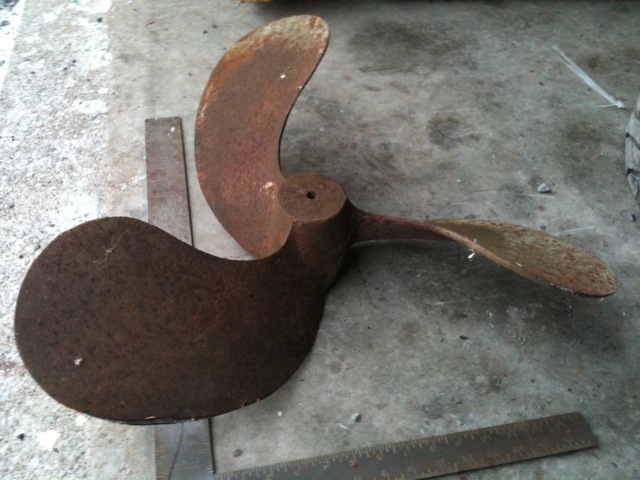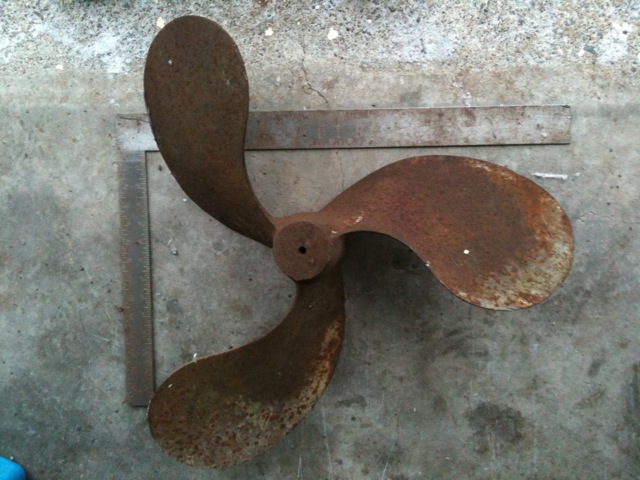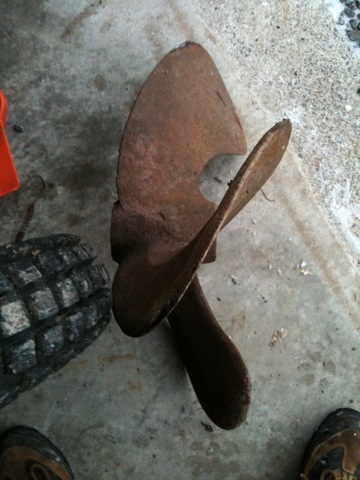| Author |
Message |
    
D.W.Southam
Member
Username: trials
Post Number: 9
Registered: 12-2011

| | Posted on Saturday, December 31, 2011 - 04:27 pm: | 




|
I don't have any of grandpa's motors, but I do have one of his props! Maybe somebody has a boat it belongs on?


 |
    
D.W.Southam
Member
Username: trials
Post Number: 15
Registered: 12-2011

| | Posted on Sunday, January 01, 2012 - 08:10 am: | 




|
Another possibility I have been considering; could this be an original 'master' prop for creating sand castings in the production of propellers?
...If anyone has knowledge or experience with the sand cast process, materials and/or propeller design, I would be very keen on having your input, Thx. |
    
William Schaller
Senior Member
Username: billschaller
Post Number: 462
Registered: 12-2003

| | Posted on Sunday, January 01, 2012 - 11:46 am: | 




|
it does not look like the shaft was ever drilled, so it is either an unfinished prop, or a pattern. Most patterns at the time were made from wood, but I am unsure about how props were made. Is it brass or cast iron? |
    
D.W.Southam
Member
Username: trials
Post Number: 16
Registered: 12-2011

| | Posted on Sunday, January 01, 2012 - 02:45 pm: | 




|
...I thought the same thing for decades, that it was an unfinished or defective prop, but the more I read and study it the more convinced I am this is a pattern!
I don't believe a wooden propeller pattern of this size and shape could be constructed stable or sturdy enough to survive repeated use over several years of production in a foundry.
I should think Bronze props would have been typical and the material of choice for a finished product.
The location it was discovered in (basement of 62 Laing Street - family home not shop) and the fact there is only one 3/8" x 1" threaded hole on the aft side, leads me to believe this pattern prop was threaded onto a positioning bolt in the 'drag' of a moulding box.
The 3/8" threaded bolt hole makes no sense if you are just going to drill it out anyway and not strong enough to serve any mechanical purpose.
From my limited research of sand cast process, the hole for the shaft would have been defined by a roughly 1 " 'core' added before the pour and could possibly incorporate a keyway slot. Drilling a significantly large hole through 5" of solid cast iron and then adding a keyway would not be a simple task in any era let alone the early 1900's
The diameter is equal to slightly over 24" (casting patterns were made slightly large to accommodate shrinkage and post cast surface finishing.)
Anyway; That's how I would make it if I was my grandfather ( and in a strange genetic kind of way I guess I am ;)
It weighs 26 lbs, Appears to be made of Cast Steel or Iron (contemplating touching a grinder to it to see what the sparks and polished material look like) |
    
Keith kinney
Member
Username: kkinney
Post Number: 14
Registered: 04-2011
| | Posted on Sunday, January 01, 2012 - 05:25 pm: | 




|
You said the 3/8" hole is threaded? If it was used for a pattern this would make since. Once they packed the sand they would have had to have removed the pattern. They would do this by threading a bolt into this hole to provide a "handle" for removing the pattern without damaging the imprint in the sand. If you go to Youtube and watch some of the foundry/sand casting videos you'll see this practice in use. I'd vote that it was his pattern.
Keith |
    
Robert
Senior Member
Username: robert
Post Number: 462
Registered: 07-2003
| | Posted on Wednesday, January 04, 2012 - 10:57 am: | 




|
Pattern idea makes perfect sense to me. Once you had made one of those in wood, who would want to have to make another!? And besides, a wooden pattern wouldn't last long and would be inclined to deform as the mold was packed anyway. |
    
Spence Kerrigan
Advanced Member
Username: kerrigan
Post Number: 40
Registered: 06-2008

| | Posted on Wednesday, January 04, 2012 - 11:49 am: | 




|
The consensus that the prop is a pattern has convinced me to give up searching for the boat the prop belongs on. |
    
D.W.Southam
Member
Username: trials
Post Number: 20
Registered: 12-2011

| | Posted on Thursday, January 05, 2012 - 08:09 pm: | 




|
Canvassing for opinions; Does it make sense to clean it up and paint or plate it in an effort to preserve it, or would that depreciate it's intrinsic historic value? |
    
Andrew Munns
Advanced Member
Username: johnoxley
Post Number: 48
Registered: 04-2010
| | Posted on Friday, January 06, 2012 - 06:55 am: | 




|
If left untreated, it will rust further. Can you find any trace of a painted coating - if so, gentle grit blast and paint would be authentic finish - probably satin gray (auto primer surfacer). If absolutely no trace of paint, a transparent coating is needed to prevent future rust. Avoid rust converters. Engine restorers burnish in a 50% thinned matt varnish with coarse steel wool - use gloves. |
    
Robert
Senior Member
Username: robert
Post Number: 464
Registered: 07-2003
| | Posted on Saturday, January 07, 2012 - 05:05 pm: | 




|
Glass bead it and paint it I'd say. Maybe you can find some information in old catalogues at museums about how old this pattern is and what it was originally intended for. You might even have a couple cast if you find a friendly foundry and a market for them. |
    
John Davis
Senior Member
Username: johnny
Post Number: 434
Registered: 03-2006

| | Posted on Monday, January 09, 2012 - 01:07 pm: | 




|
I'm not as knowledgeable as some of the marine people on this forum but I do know that props were cast of iron a steel and painted back in the day mostly for fresh water application. Probably at a cheaper price. I have one of the old iron props still on the shaft in my shop. I'm going to say that it is a cast prop that has not been machined for a shaft. On the other hand I suppose that it is possible that it could be a cast duplicate of the wood master prop and was used to make the sand molds. There would be less chance of the iron getting damaged verses the wood prop making the molds over and over again. |


